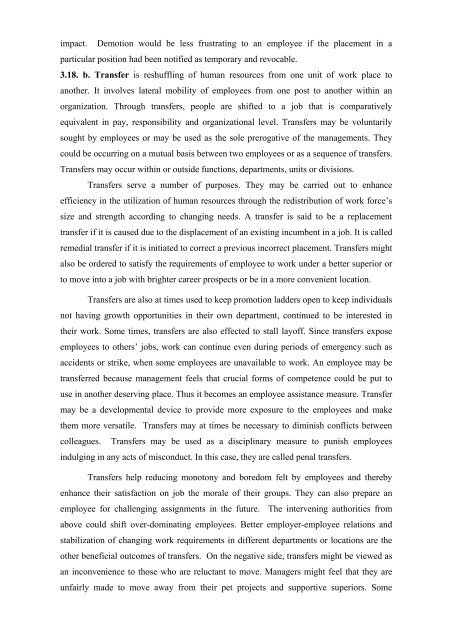UNIT – I Lesson 1 HRM – AN OVERVIEW Lesson Outline Nature of ...
UNIT – I Lesson 1 HRM – AN OVERVIEW Lesson Outline Nature of ...
UNIT – I Lesson 1 HRM – AN OVERVIEW Lesson Outline Nature of ...
You also want an ePaper? Increase the reach of your titles
YUMPU automatically turns print PDFs into web optimized ePapers that Google loves.
impact. Demotion would be less frustrating to an employee if the placement in a<br />
particular position had been notified as temporary and revocable.<br />
3.18. b. Transfer is reshuffling <strong>of</strong> human resources from one unit <strong>of</strong> work place to<br />
another. It involves lateral mobility <strong>of</strong> employees from one post to another within an<br />
organization. Through transfers, people are shifted to a job that is comparatively<br />
equivalent in pay, responsibility and organizational level. Transfers may be voluntarily<br />
sought by employees or may be used as the sole prerogative <strong>of</strong> the managements. They<br />
could be occurring on a mutual basis between two employees or as a sequence <strong>of</strong> transfers.<br />
Transfers may occur within or outside functions, departments, units or divisions.<br />
Transfers serve a number <strong>of</strong> purposes. They may be carried out to enhance<br />
efficiency in the utilization <strong>of</strong> human resources through the redistribution <strong>of</strong> work force’s<br />
size and strength according to changing needs. A transfer is said to be a replacement<br />
transfer if it is caused due to the displacement <strong>of</strong> an existing incumbent in a job. It is called<br />
remedial transfer if it is initiated to correct a previous incorrect placement. Transfers might<br />
also be ordered to satisfy the requirements <strong>of</strong> employee to work under a better superior or<br />
to move into a job with brighter career prospects or be in a more convenient location.<br />
Transfers are also at times used to keep promotion ladders open to keep individuals<br />
not having growth opportunities in their own department, continued to be interested in<br />
their work. Some times, transfers are also effected to stall lay<strong>of</strong>f. Since transfers expose<br />
employees to others’ jobs, work can continue even during periods <strong>of</strong> emergency such as<br />
accidents or strike, when some employees are unavailable to work. An employee may be<br />
transferred because management feels that crucial forms <strong>of</strong> competence could be put to<br />
use in another deserving place. Thus it becomes an employee assistance measure. Transfer<br />
may be a developmental device to provide more exposure to the employees and make<br />
them more versatile. Transfers may at times be necessary to diminish conflicts between<br />
colleagues. Transfers may be used as a disciplinary measure to punish employees<br />
indulging in any acts <strong>of</strong> misconduct. In this case, they are called penal transfers.<br />
Transfers help reducing monotony and boredom felt by employees and thereby<br />
enhance their satisfaction on job the morale <strong>of</strong> their groups. They can also prepare an<br />
employee for challenging assignments in the future. The intervening authorities from<br />
above could shift over-dominating employees. Better employer-employee relations and<br />
stabilization <strong>of</strong> changing work requirements in different departments or locations are the<br />
other beneficial outcomes <strong>of</strong> transfers. On the negative side, transfers might be viewed as<br />
an inconvenience to those who are reluctant to move. Managers might feel that they are<br />
unfairly made to move away from their pet projects and supportive superiors. Some
















